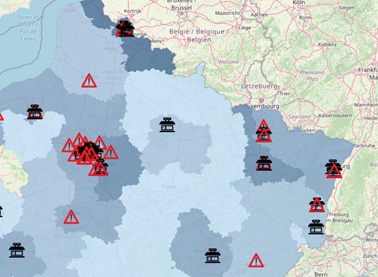The impact of competition on store performance and growth

Deciding where to locate your next outlet is far from being an arbitrary and easy decision, especially when the area is competitive. Mapping offers real opportunities for optimisation.
The challenges of segmentation: Which geographical areas to focus on given the impact of competition?
When looking to set up a new outlet, one is systematically divided between two questions related to the impact of competition.
Should we locate where some of our competitors are already located in order to benefit from existing traffic?
Or should we focus on areas where our competitors are less present?

This is a difficult question and one must be cautious in answering it at first sight. It is therefore necessary to study the subject in some detail in order to measure whether or not performance is affected by the presence of competitors.
The first approach to analysis that can be taken is based on mapping. Indeed, if the number of competitors is not too high, it will be fairly easy to produce a map representing the turnover generated by the points of sale, on a relevant geographical level, by positioning both one’s own points of sale and those of competitors. This map will then show whether the level of turnover is higher or lower depending on the density of its own shops and those of its competitors. An example of this can be seen on the map above.
Statistical models to measure the impact of competition
While this approach is interesting because it is simple to implement and very visual, it is unfortunately not very precise, especially if you have to deal with a large number of competitors.
In this case, it may be interesting to use statistical models, and in particular regression models, to explain the level of turnover observed in the shops according to a certain number of explanatory variables. For example, it will be possible to associate endogenous variables (type of shop, surface area, etc.) with exogenous variables (customer profiles in the catchment area, competitors present in the area, etc.) in order to determine the most relevant model. Once the model has been obtained, it will be possible to identify the weight of each component in the explanatory power of the model. This will make it possible to determine the weight of endogenous variables, the profile of the catchment area or the competition on turnover.
Methodology for implementation and benefits of these models
In terms of implementation, you are strongly advised to follow the following process:
- Identify the catchment areas of your shops. This is key in several ways: identify the competitors present in the sector, better understand the profile of the households present in the area
- Collect as much data as possible, both endogenous (shop size, type, age, etc.) and exogenous (competition, open data, etc.)
- Build the model, check it, adjust it and validate it on another data set (another period for example)
Once we have the model, we can then answer our initial question: does the presence of competitors have a positive or negative impact on turnover?
If you implement this type of model, you will quickly see that the answer is more nuanced because some competitors will have a positive impact while others will have a negative impact on your business.
It should be noted that this type of model has a second interest: facilitating the business projections linked to the establishment of a shop. Indeed, the equation obtained will make it possible to compare different potential locations and to define the level of turnover expected in each case.
How does datacadabra help you deal with these subjects?
datacadabra has a set of methods that allow you to respond to this type of problem. The Map module allows you to integrate your points of interest (POI) natively, whether they concern your shops or your competitors’ shops. You will thus be able to easily visualize your commercial performance on maps created in a few clicks. The Predict module will soon be enriched with a new method allowing you to measure the impact of the competition, so you can easily implement this type of model.
Want to know more? Do not hesitate to contact us or to ask for a datacadabra demo.